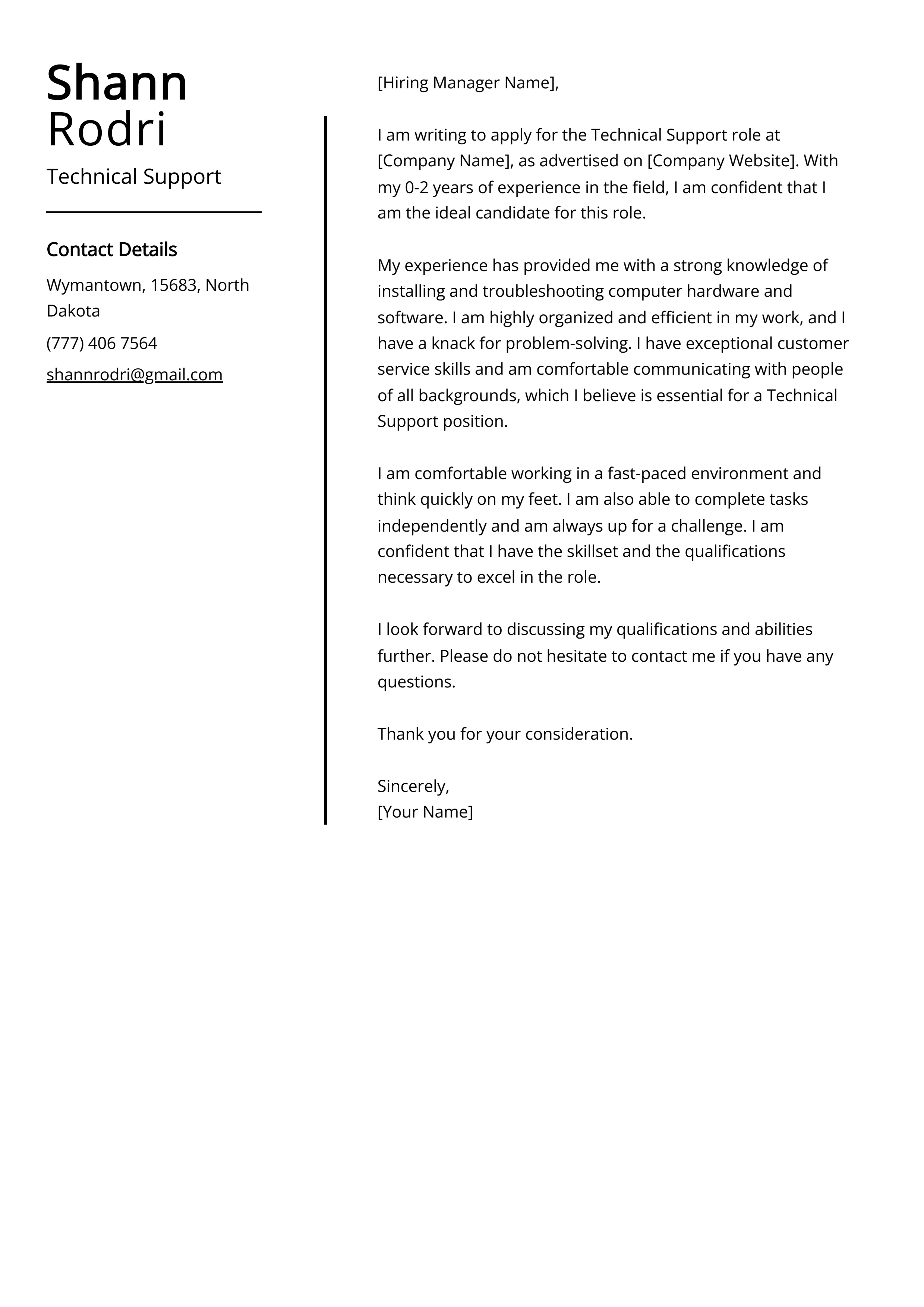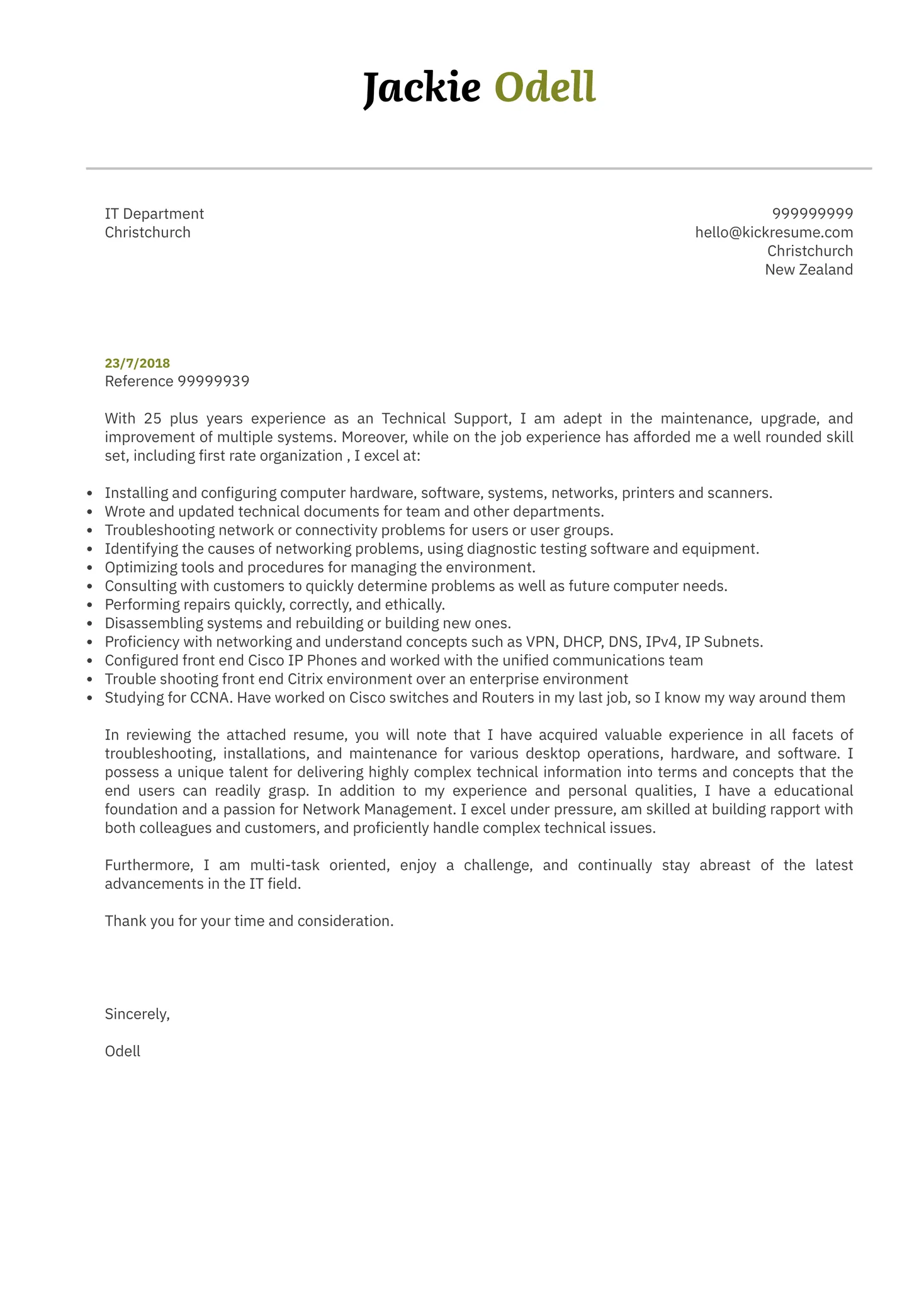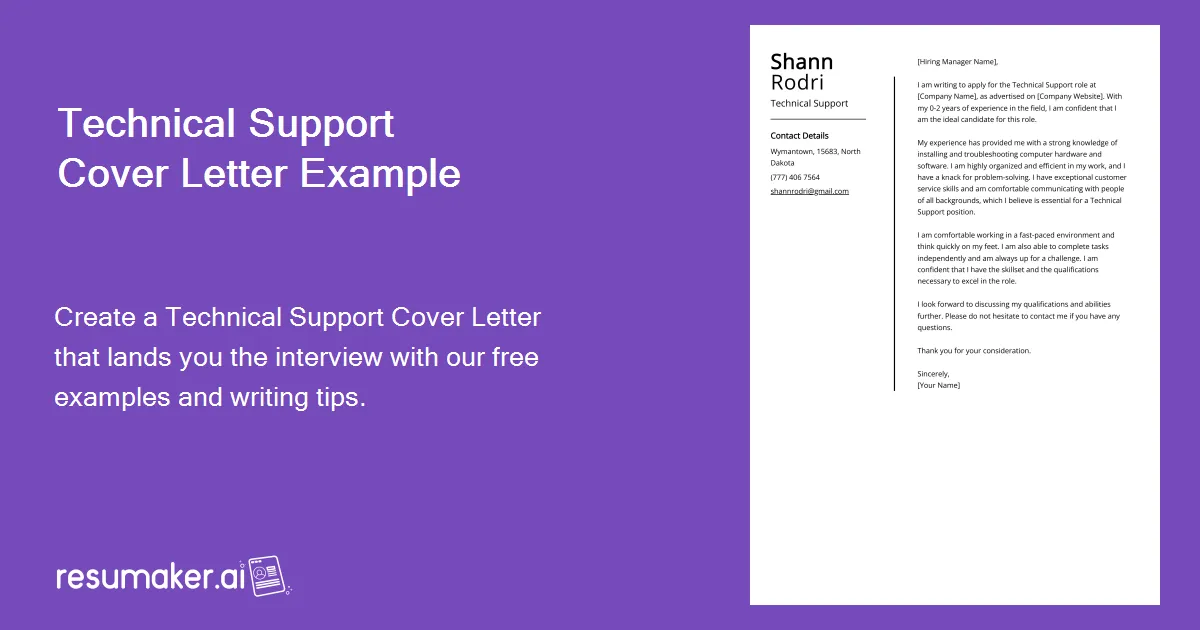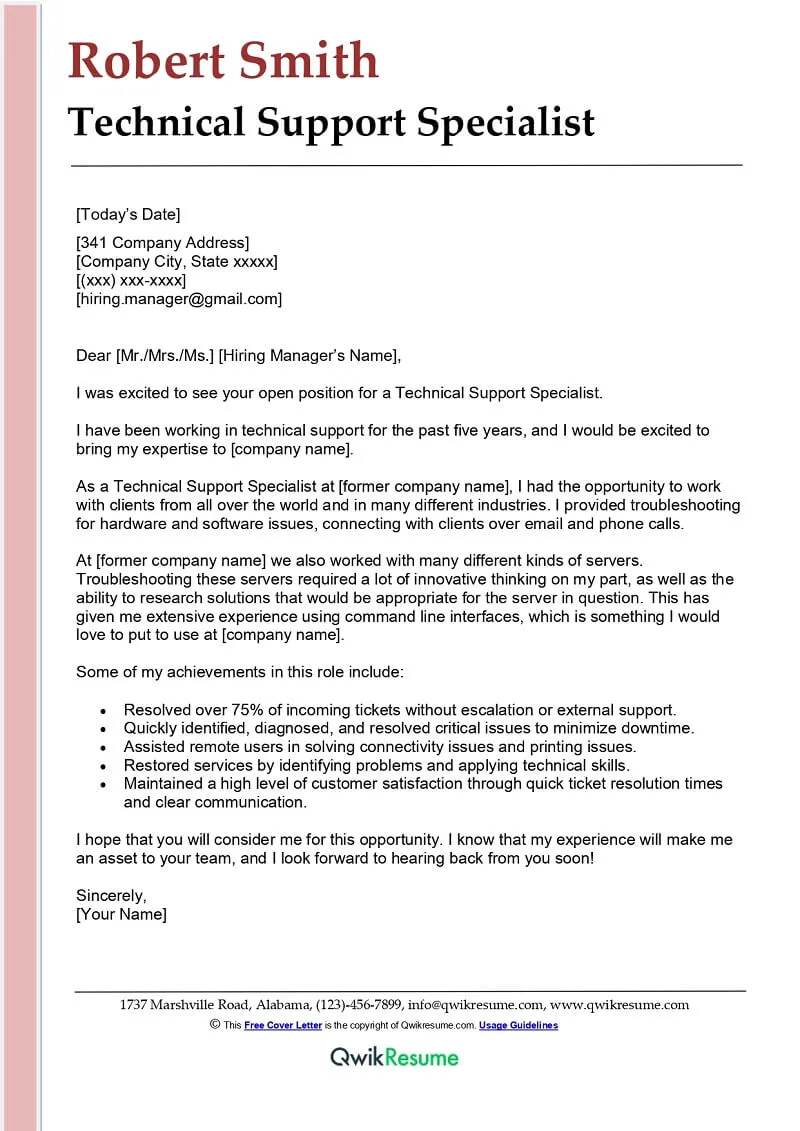Understanding the Importance of a Technical Support Cover Letter
In the competitive field of technical support, a well-crafted cover letter is your initial opportunity to create a favorable impression. Unlike a resume, which provides a chronological overview of your experience, a cover letter enables you to narrate a story, directly connecting your skills and experiences to the particular job requirements. It’s not just a formality; it’s a valuable tool that can significantly boost your chances of securing an interview. A compelling cover letter showcases your personality, enthusiasm, and comprehension of the company’s needs, distinguishing you from other applicants and making your application memorable. It’s where you demonstrate your capacity to communicate effectively and your genuine interest in the position. By crafting a targeted cover letter, you can emphasize your most pertinent skills and achievements, thereby capturing the hiring manager’s attention. It’s an opportunity to address any potential concerns or gaps in your resume and express your unique value proposition. A well-written cover letter can transform a good resume into a great application, potentially leading to a job offer.
Key Components of a Technical Support Cover Letter
A technical support cover letter requires several key components to be effective. These elements work together to highlight your qualifications and construct a strong case for your candidacy. Start with a clear and professional header that includes your contact information, followed by a personalized greeting to the hiring manager or the specific contact person. The opening paragraph must immediately capture the reader’s attention by stating the position you are applying for and highlighting a key skill or accomplishment that aligns with the job description. The body of the letter must then detail your relevant technical skills, providing specific examples of how you’ve used these skills in past roles, backed up by quantifiable achievements. It should also emphasize your soft skills, such as communication and problem-solving, demonstrating your ability to not only fix technical issues but also interact with clients and colleagues effectively. Lastly, clearly express your interest in the company, highlighting why you’re interested in this specific role and this specific company. Conclude with a strong call to action, expressing your enthusiasm for the opportunity and your availability for an interview. Remember, each of these sections contributes to a cohesive message that convinces the hiring manager you are the perfect fit.
Contact Information and Salutation

Start your cover letter with a professional header, including your full name, address, phone number, and email address. Make sure your email address is professional; avoid using nicknames or unprofessional language. Below your contact information, include the date, followed by the hiring manager’s name and title, and the company’s name and address. Always address the hiring manager by name if possible. Researching the name of the hiring manager shows you’ve taken the initiative and are genuinely interested in the role. If you are unable to find the name, use a professional salutation like “Dear Hiring Manager.” This level of personalization makes your cover letter more engaging and demonstrates your attention to detail. Proper formatting in this section not only looks professional but also makes it easy for the hiring manager to contact you.
Professional Greeting
A professional greeting sets the tone for the rest of your cover letter. Avoid generic greetings like “To Whom It May Concern,” as they lack personalization and make your application appear less engaging. The best approach is to directly address the hiring manager by name. This shows you’ve done your research and are truly interested in the position. If the hiring manager’s name is unknown, use a professional alternative such as “Dear Hiring Manager.” This approach is still respectful and signals that you understand the importance of a formal tone. Remember, the greeting is the first impression you make; make sure it’s a good one.
Opening Paragraph Grab the Reader’s Attention
The opening paragraph is your chance to immediately capture the reader’s interest. Instead of a generic introduction, use a strong hook that immediately establishes your connection to the job. Start by clearly stating the position you are applying for, mentioning where you saw the advertisement or how you learned about the opportunity. Then, quickly highlight a key skill or accomplishment that is directly relevant to the job description. This could be a specific certification, a successful project, or a notable achievement in a previous role. Keep the opening concise and focused on what makes you an excellent candidate. The goal is to pique the hiring manager’s interest and make them want to read further. It’s an opportunity to make a great first impression and convince the reader that you have what they are looking for. A well-crafted opening paragraph can set the tone for the entire letter and significantly increase your chances of being considered.
Highlighting Your Technical Skills and Experience

The body of your cover letter should focus on showcasing your relevant technical skills and experience. This is where you prove that you are the right fit for the job by demonstrating your ability to meet the requirements outlined in the job description. Don’t just list your skills; provide specific examples of how you have applied them in previous roles. Use the STAR method (Situation, Task, Action, Result) to illustrate your achievements and how you have successfully resolved technical issues. For example, if the job description emphasizes experience with network troubleshooting, describe a time you identified and resolved a complex network problem. If the job requires expertise with a particular software or hardware, highlight your proficiency and provide an example of how you utilized it in the past. Make sure to align your skills with the job requirements; this makes it clear that you have the necessary qualifications to succeed in the role.
Showcasing Relevant Technical Skills
When highlighting your technical skills, be specific and provide concrete examples. Instead of simply stating that you are proficient in Windows, explain the depth of your experience, for example, you can mention that you have experience with Active Directory, Group Policy Management, and troubleshooting Windows Server environments. If the job requires experience with specific software or hardware, mention your experience, including how long you’ve used the tools and projects you’ve worked on. Back up your claims by providing examples of projects where you successfully used these skills. Quantify your achievements wherever possible; for example, you can say “Reduced server downtime by 30% by implementing a new monitoring system”. Tailor your list of skills to match the job description, and demonstrate your proficiency through actionable examples and specific results.
Quantifying Achievements
Quantifying your achievements is a powerful way to demonstrate the impact of your technical skills. Instead of making vague claims, use numbers and statistics to highlight your successes. For example, you can describe how you “reduced help desk tickets by 25% by implementing a new remote support system” or “improved network performance by 15% through optimization efforts.” Use metrics such as cost savings, time saved, or increased efficiency to demonstrate the value you bring to the role. By quantifying your achievements, you make your accomplishments more tangible and provide concrete evidence of your abilities. This helps the hiring manager see the real-world results you can deliver. In your cover letter, focus on achievements that are most relevant to the job requirements, using numbers and data to support your claims.
Demonstrating Soft Skills and Qualities

While technical skills are essential for a technical support role, soft skills and personal qualities are just as important. Employers want to know that you can communicate effectively, work well in a team, and solve problems efficiently. Highlight your problem-solving skills by describing how you approach and resolve technical issues. Provide an example of a time you used critical thinking to diagnose and fix a challenging problem. Showcase your communication skills by mentioning your ability to explain technical concepts clearly to non-technical users, both verbally and in writing. If you have experience working in a team, mention how you collaborated with colleagues to achieve common goals. Make sure to include examples that highlight your ability to handle stress, manage your time, and be proactive.
Emphasizing Problem-Solving Abilities
Problem-solving is at the core of technical support. In your cover letter, emphasize your ability to approach and resolve technical issues methodically and efficiently. When providing examples, explain the steps you took to diagnose and resolve problems. Demonstrate your ability to analyze the root cause of issues, find effective solutions, and implement them in a way that minimizes downtime and disruption. If possible, provide specific examples of challenging problems you solved and the strategies you used. Showcase your critical thinking skills and your ability to approach problems systematically. Highlight your adaptability and how you learn from experience. Show the hiring manager that you’re not only good at solving problems, but also at preventing them in the future.
Showcasing Communication and Interpersonal Skills
Communication and interpersonal skills are crucial in technical support roles. Showcasing your ability to explain technical information clearly and concisely, both verbally and in writing, is essential. Highlight your ability to communicate technical concepts to non-technical users in a way that is easy to understand. Describe your experience interacting with customers, colleagues, and vendors. Mention instances where you successfully de-escalated tense situations or resolved conflicts professionally. Explain how you build rapport with clients and how you provide excellent customer service. Include examples that highlight your listening skills, empathy, and patience. Emphasize your ability to work effectively in a team, share information, and collaborate with others to achieve common goals. By demonstrating these soft skills, you show that you not only possess the technical expertise but can also thrive in a customer-facing support role.
Explaining Your Interest in the Company and Role

The best cover letters demonstrate that you’ve done your research and are genuinely interested in the company and the specific role. Explain why you are interested in the company and what specifically appeals to you about their mission, values, or products. Mention any unique aspects of the company that you admire. Then, explain why you are interested in the technical support role. Describe how the role aligns with your career goals and what you hope to achieve in the position. Emphasize your enthusiasm for the opportunity to contribute to the company’s success. This not only shows you are genuinely interested in the position, but also that you have a clear understanding of what the role entails and how your skills and experience align with the company’s goals. By showing that you’re invested in their success, you make a compelling case for why they should hire you.
Researching the Company Culture and Values
Before you write your cover letter, research the company’s culture and values. This research provides the foundation for tailoring your letter to their specific needs. Visit the company’s website and social media profiles to get an understanding of their mission, values, and recent projects. Look for information about the company’s culture, work environment, and any awards or recognition they have received. In your cover letter, reference the company’s values and show how your skills and experience align with them. By demonstrating that you understand their culture and values, you will position yourself as someone who fits well within the company and is genuinely interested in the role. This targeted approach shows that you are not just sending a generic application but are carefully considering the company’s needs and priorities.
Tailoring Your Letter to the Specific Job
A generic cover letter is unlikely to impress a hiring manager. Tailor your cover letter to each specific job you apply for by carefully reviewing the job description and identifying the key requirements. Highlight your skills and experiences that directly match the job’s needs. Use keywords from the job description throughout your cover letter to demonstrate that you meet the specified requirements. Address each of the key responsibilities or qualifications mentioned in the job description, providing examples from your past experiences to illustrate how you would excel in this role. By carefully tailoring your letter to each specific job, you will show the hiring manager that you have taken the time to understand the role and are a strong fit.
Call to Action and Closing

End your cover letter with a strong call to action and a professional closing. State your enthusiasm for the opportunity and reiterate your interest in the position. Include a clear statement that you are available for an interview and how they can best reach you. Thank the hiring manager for their time and consideration. Keep the closing concise and professional, such as “Sincerely” or “Best regards,” followed by your full name. Ensure that you have reviewed the entire letter for any errors before submitting it, to leave a lasting positive impression.
Expressing Enthusiasm and Availability
In your closing, express your genuine enthusiasm for the opportunity. Reiterate your interest in the role and why you believe you are a great fit. Clearly state your availability for an interview, including your preferred method of contact (e.g., phone or email) and any relevant time preferences. Make it easy for the hiring manager to move forward by providing your contact information again, and thanking them for their time and consideration. End with a professional closing such as “Sincerely” or “Best regards.” Your closing should leave a positive impression and encourage them to contact you.
Proper Formatting and Proofreading
Proper formatting and careful proofreading are essential to ensure your cover letter makes a professional impression. Your cover letter should be easy to read and well-organized. Use a clear, professional font like Arial or Times New Roman, and keep the font size between 10 and 12 points. Use standard 1-inch margins and single-spacing for the body of the letter. Divide your letter into clear paragraphs with appropriate spacing between each. This makes it easier for the hiring manager to read and comprehend the information. Ensure your letter is free from any grammatical errors, spelling mistakes, or typos. Before sending your cover letter, proofread it carefully and consider asking a friend or family member to review it as well. A well-formatted and error-free cover letter demonstrates your attention to detail and professionalism, which can make a positive impression on the hiring manager.
Formatting Guidelines

Proper formatting helps your cover letter appear professional and easy to read. Use a clear, professional font, such as Arial or Times New Roman, and keep the font size between 10 and 12 points. Use standard 1-inch margins and single-spacing for the body of the letter. Align the text to the left, and ensure that each paragraph is clearly separated with spacing. Include your contact information at the top, and the date, the hiring manager’s name, and the company address. Maintaining a consistent format throughout the document makes your cover letter visually appealing and easy to navigate. A well-formatted cover letter indicates your attention to detail and professionalism.
Proofreading for Errors
Proofreading your cover letter is a critical step to ensure your application is free from errors. Before submitting, read your cover letter carefully and check for any grammatical mistakes, spelling errors, and typos. It can be helpful to read your letter aloud to identify awkward phrasing or areas where the wording could be improved. It is often beneficial to have a friend or family member read your letter and offer feedback. Proofreading is a crucial step to guarantee your application will make the positive first impression you want.
Samples of Effective Technical Support Cover Letters
Reviewing samples of effective technical support cover letters can provide valuable insights and guidance. Look for examples that are tailored to the specific industry or role you are applying for. Pay attention to the format, the tone, and the way the candidate highlights their skills and experience. Analyze how the letter begins, how the candidate explains their technical skills and experience, and how they demonstrate their enthusiasm for the company. By studying different cover letter samples, you can gain inspiration and ideas to help you create a cover letter that stands out. Make sure to adapt the samples to your own unique background and skills. The best samples will inspire, not be copied, and will guide you to create a winning cover letter.
Tips for Writing a Strong Cover Letter
Writing a strong cover letter requires careful attention to detail and a strategic approach. Begin by researching the company and tailoring your letter to the specific role. Highlight your key skills and experiences in a clear and concise manner. Use action verbs and quantify your achievements to demonstrate your value. Make sure to proofread your letter carefully for any errors. By following these tips, you can increase your chances of getting noticed and securing an interview. Always write in a professional tone, and show your enthusiasm for the company and position.
Using Keywords Effectively
Use keywords from the job description effectively in your cover letter to demonstrate that you are a good fit for the role. Identify the key skills, qualifications, and responsibilities mentioned in the job description. Incorporate these keywords naturally into your letter, highlighting your relevant skills and experience. When possible, align your achievements with the job requirements, using the same language and terminology as the job description. This helps the hiring manager quickly recognize that you have the required skills and expertise. Be careful not to overstuff your letter with keywords, however, as this can make it appear unnatural. The goal is to seamlessly integrate relevant keywords to show that you meet the job’s key requirements.
Keeping it Concise and Engaging
Keep your cover letter concise and engaging to capture the hiring manager’s attention. Aim for a letter that is no more than one page in length. Avoid using overly complex sentences or jargon that may confuse the reader. Use clear, concise language and highlight your most important skills and experiences. Use action verbs to make your accomplishments sound more impactful. By keeping your letter concise and engaging, you make it easier for the hiring manager to quickly assess your qualifications and understand why you are the best candidate for the job.
